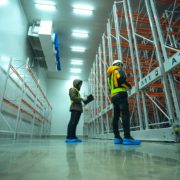In November 2023, the pharmaceutical industry reached a major milestone: the deadline for implementing the Drug Supply Chain Security Act (DSCSA) requirements for unit-level serialization and electronic track-and-trace. As we enter 2025, full enforcement of DSCSA is coming into effect, fundamentally changing how prescription drugs are tracked through the supply chain. This section provides an update on DSCSA compliance in 2025, explores how advanced technologies like blockchain are enhancing track-and-trace, and offers practical recommendations to maintain compliance.
DSCSA in 2025: From Deadlines to Enforcement
The DSCSA, enacted in 2013, set out a 10-year plan to build an interoperable electronic system to identify and trace prescription drugs at the package level across the U.S. supply chain. Key phases included lot-level tracing (2015), product serialization with unique identifiers (2017), and full electronic tracing with verification by 2023 (dlapiper.com). While the law’s final phase technically took effect on November 27, 2023, the FDA recognized that many trading partners were not fully ready.
To avoid supply disruptions, FDA issued guidance in mid-2023 establishing a one-year “stabilization period” until Nov 27, 2024, during which it would not enforce the new electronic tracing requirements (fda.gov). This grace period gave manufacturers, wholesalers, pharmacies (dispensers), and 3PLs extra time to test and mature their systems for sending, receiving, and storing transaction data electronically. By late 2024, FDA officials made clear that no further delays would be granted in 2025 (raps.org).
As of 2025, the DSCSA’s enhanced drug distribution security rules are in force – albeit with some phased temporary exemptions. In October 2024, FDA announced it would exempt certain partners for a few months into 2025 if they had made sincere progress but needed a bit more time (dlapiper.com). The exemptions (not extensions of the law, but discretionary relief) set new final compliance dates based on entity type. For example, manufacturers and repackagers must fully comply by May 27, 2025, and wholesalers by August 27, 2025. Small retail pharmacies (“small dispensers”) were also given some accommodations (dlapiper.com). By the end of 2025, essentially all prescription drug trading partners must be operating under DSCSA’s electronic track-and-trace system, with no paper-based processes.
The impact of DSCSA enforcement is significant. Every package of prescription medication now carries a unique product identifier (serialization), and each time ownership changes (manufacturer to wholesaler, wholesaler to pharmacy, etc.), an electronic record of that transaction is created and passed along. This creates an unbroken chain of custody. In practice, this means:
- Manufacturers must upload transaction information (product, lot, serial number, dates, parties) into secure databases and provide it to their customers electronically.
- Wholesalers and distributors must be able to receive this data, maintain it, and pass it forward. They also need to verify that any returned saleable units are legitimate by checking the identifier.
- Pharmacies must receive the data and store it for at least 6 years, and be capable of responding to verification requests (though exemptions have given many pharmacies until 2025/26 to fully integrate systems).
- All parties must only transact with authorized trading partners (licensed entities) and have systems to detect and quarantine suspicious or illegitimate products.
The ultimate goal is a safer drug supply. By 2025, if a counterfeit or recalled drug is found, the electronic traceability will allow rapid identification of where it came from and where else it went, enabling targeted recalls. This is a major improvement in protecting patients from fake or harmful medicines. The FDA notes that DSCSA gives it and industry better ability to keep counterfeit, stolen, or contaminated drugs out of the U.S. market (dlapiper.com).
Leveraging Blockchain and Advanced Tracking Technologies
Implementing DSCSA has been a technical challenge, but it’s also spurred innovation. Blockchain technology emerged as a promising tool to achieve the required interoperability and security in track-and-trace. In 2019, a consortium called MediLedger conducted an FDA pilot project using blockchain for DSCSA compliance. The pilot demonstrated that a blockchain-based system can feasibly handle package-level drug tracing and verification under DSCSA (tabletscapsules.com). Key findings were that a single blockchain network could achieve the throughput and speed needed for industry, while preserving data privacy via techniques like zero-knowledge proofs (tabletscapsules.com). In short, blockchain can provide an immutable, distributed ledger of drug transactions without exposing competitive data to all participants.
Several pharma companies and solution providers have since explored blockchain for track-and-trace. For example, the MediLedger network showed that blockchain could validate product identifiers (to help verify authenticity) and track provenance from manufacturer to dispenser (tabletscapsules.com). Because every block entry is time-stamped and tamper-evident, this technology adds trust that the supply chain data has not been altered. It can also automate alerts if a serial number is not what or where it’s supposed to be.
Beyond blockchain, other advanced tracking technologies are bolstering compliance and efficiency:
- Shared Databases and Cloud Platforms: Industry has largely converged on using EPCIS (Electronic Product Code Information Services) standards for data exchange. Many are using cloud-based traceability platforms (offered by vendors like TraceLink, SAP, etc.) to share serialized data with partners. These act as secure, shared record repositories that all authorized parties can query as drugs move through the supply chain.
- AI and Data Analytics: With millions of transaction records being generated, companies are applying AI-driven analytics to monitor for anomalies. For instance, AI can flag if a product’s journey deviates from expected patterns (which could indicate diversion or counterfeit insertion). AI tools also help manage data quality issues, ensuring the huge volume of information is accurate and usable for compliance.
- Internet of Things (IoT) & Real-Time Tracking: While DSCSA is mostly about chain-of-custody, some firms are integrating it with IoT tracking for added value. IoT sensors (like smart labels or RFID) can report a drug’s location and condition in real time. This isn’t mandated by DSCSA, but it complements security – for example, confirming that a high-value oncology drug stayed in the correct temperature range while in transit. Some packaging now includes RFID tags to speed up scanning of serialized codes, allowing bulk verification without line-of-sight barcode scans.
- Mobile and Authentication Apps: At the pharmacy or patient level, mobile apps can scan a drug’s 2D matrix barcode and check it against the DSCSA database. This could eventually empower pharmacists (or even patients) to instantly verify a medicine’s legitimacy. Manufacturers are also exploring adding anti-tampering and authenticity features (like holograms or digital watermarks) that tie into the electronic records.
Notably, blockchain consortia continue to develop. The FDA pilot’s success has encouraged initiatives like the PharmaLedger project in Europe and others globally to use blockchain for medicine traceability (tabletscapsules.com). While not every company will join a blockchain network, the concept of a secure, unified ledger is influencing system design. Even without full blockchain, the DSCSA requirements push toward interconnected systems. Many companies have formed interoperability hubs – essentially shared platforms where multiple manufacturers and distributors connect – to meet DSCSA data exchange needs. This digitization of the supply chain is not only a compliance effort, but also is yielding business benefits like better visibility of inventory and reduction of paperwork.
Staying Compliant: Recommendations for Companies
For pharmaceutical manufacturers, distributors, and dispensers, 2025 is the year that DSCSA compliance can no longer be delayed. Non-compliance risks not only regulatory action but also business disruption – partners will be unwilling to transact with an entity that can’t provide the required traceability data. Here are practical recommendations to remain compliant:
- Solidify Your Serialization and Data Systems: By now, all manufacturers should have fully serialized their product packaging with the required GS1 barcodes (including GTIN, serial number, lot, expiry). Ensure your IT systems (ERP, warehouse management, etc.) are integrated with serialization management software so that every product that leaves your facility has an accurate electronic product code recorded and accessible. Distributors and pharmacies likewise must have systems to capture and store transaction information. If you haven’t already, adopt a DSCSA-compliant solution or work with a 3PL provider experienced in track-and-trace to handle this on your behalf.
- Establish Interoperable Data Exchange: The law mandates electronic exchange of transaction data in a secure, interoperable manner. This can be achieved via direct connections with partners or through intermediary platforms. Many companies use EPCIS XML or JSON messages to transmit data. Test connections with all your major trading partners. Where possible, join established networks or use provider services that connect to multiple parties (to avoid building one-to-one connections with every customer). The FDA expects that by 2025, all companies have “initiated their systems and processes” for electronic data exchange (dlapiper.com). If you experience data errors or outages, have a troubleshooting plan – but do not revert to paper.
- Use Verification and Alert Tools: Under DSCSA, when a product identifier is queried (e.g., during a return or an investigation), you must promptly verify it. Implement or subscribe to a verification router service (VRS) – an industry tool that routes verification requests for saleable returns to the appropriate manufacturer’s database. Also, set up internal alerts for any suspect product scenarios: for example, if you receive a serial number that was never issued or one that has already been dispensed elsewhere, your system should flag it for investigation. Immediate electronic notification to FDA is required if an illegitimate product is confirmed.
- Embrace Advanced Track-and-Trace Tech: Consider leveraging the new tech solutions to enhance compliance. Blockchain-based systems can add an extra layer of security – some early adopters are already working in blockchain networks for DSCSA, which could eventually become industry standard. At minimum, maintain a secure, immutable log of all transactions (many cloud solutions provide this) to create an audit trail. Use real-time dashboards to monitor your supply chain data flows; this helps ensure you are continuously compliant and can proactively resolve issues. As one industry expert noted, integrating data analytics and visualization can improve companies’ data-sharing capabilities and help prevent financial losses and trust issues from non-compliance (pharmaceutical-technology.com).
- Train and Audit Your Team and Partners: Compliance isn’t just IT – it involves people and processes. Train your operations and supply chain staff on the new procedures for handling DSCSA information. Pharmacists and technicians at dispensing points should know how to scan and log serialized products, and what to do if something doesn’t match up. Conduct mock recalls or trace exercises to ensure you can quickly compile the transaction history of a product if needed (DSCSA calls this the “product tracing” information). Also, audit your third-party partners: verify that your contract manufacturers, 3PLs, and others you work with are compliant, since under the law everyone in the chain is accountable.
- Stay Informed on Updates: The FDA continues to provide guidance and adjustments. For example, new exceptions/exemptions can be issued (the agency can waive certain requirements in specific cases, such as for emergencies or certain product types). Keep an eye on FDA announcements and guidance documents. In late 2024, FDA outlined some exempted scenarios (like certain drop shipments, and small dispensers extension) – make sure you understand if any apply to your business (dlapiper.com). Also, monitor industry groups like HDA (Healthcare Distribution Alliance) for best practices as companies refine the systems.
By following these steps, companies can not only avoid penalties but also gain efficiency. A secure, electronic track-and-trace system reduces the chance of counterfeit products entering and builds trust with regulators and customers. It also streamlines recalls and returns. As noted in an industry roundtable, partners that fail to comply will “struggle to remain in the market” because others will not trust their capabilities (pharmaceutical-technology.com). Compliance, therefore, is not just a legal obligation but a competitive necessity in 2025.
Conclusion and Call to Action
As DSCSA enforcement comes into full effect in 2025, pharmaceutical supply chain players should view serialization and track-and-trace not as a burden, but as an opportunity to modernize and secure the supply chain. The incorporation of cutting-edge technologies like blockchain, AI, and IoT can further elevate compliance to a strategic advantage, ensuring patient safety and supply chain integrity.
Is your company ready for this new era of transparency in pharma logistics? Euro-American Worldwide Logistics offers expertise in DSCSA compliance solutions – from turnkey serialization systems to blockchain-enabled track-and-trace platforms. Our team can assess your current compliance status and help implement robust, future-proof logistics tracking. Contact Euro-American Worldwide Logistics today to ensure your pharmaceutical supply chain remains compliant and secure in 2025 and beyond.
References
FDA. (2023, Aug 30). DSCSA Compliance Policies Establish 1-Year Stabilization Period for Implementing Electronic Systems.
fda.gov
DLA Piper (Mikson, C. et al.). (2025, Jan 14). FDA Regulatory Alert: Certain DSCSA Deadline Extensions Set to Eclipse in 2025.
dlapiper.com
Pharmaceutical Technology (Spencer-Jolliffe, N.). (2024, Oct 28). Preparing for DSCSA Transition with Tech-Led Compliance.
pharmaceutical-technology.com
Tablets & Capsules Magazine (Fulton, M.). (2020, Apr 2). Track and Trace: Summary of the MediLedger DSCSA Pilot Project.
tabletscapsules.com
Pharmaceutical Commerce (Saraceno, N.). (2024, Feb 2). Peeking Behind the Curtain: Pharma 3PLs and Future Outlook. (comments by J. Saponaro on tech leaps)
pharmaceuticalcommerce.com
FDA. (2014). Drug Supply Chain Security Act (DSCSA) Tracing Requirements. – (Background on lot-level and serialization phases)
dlapiper.com










